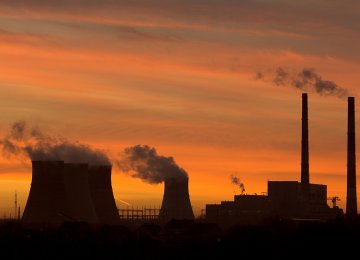The energy minister has raised the alarm on critically low levels of rainfall and dwindling water resources, linking the dry spell in Iran and other regions to the upsurge in harmful emissions across continents.
"The drought in Iran and other countries over the past 15 years is one of the adverse effects of rising greenhouse gas emissions," Hamid Chitchian was quoted as saying by IRNA on the sidelines of the launching of Rudbar Hydroelectric Dam in the western Lorestan Province.
Iran is grappling with its worst water crisis in recent history. According to reports, precipitation has fallen to the lowest levels in 50 years as the country has tapped into more than 85% of its renewable water resources.
"Greenhouse gases emissions, which come from burning fossil fuels, among other things, have had detrimental effects on the world," the minister noted echoing the warnings of an increasing number of climate scientists and environmentalists.
Iran is part of a global initiative to tackle climate change that poses a fundamental threat to places, species and people’s livelihoods.
In December last year, 195 nations including Iran signed an agreement at the Paris Climate Conference to shift away from fossil fuels with a goal of limiting a rise in average global temperatures to well below 2 degrees Celsius.
"One of the main points of the climate deal is promoting renewable energies. Iran has committed to cutting greenhouse gas emissions by 4% by 2030 and a major step to that end is boosting the capacity of renewables to 7,500 megawatts," the minister said.
Iran's installed power production capacity is slightly above 75,000 MW with hydroelectric capacity at 11,500 MW.
The legally-binding initiative, officially known as the Paris Agreement, is the first-ever universal action plan to put the world on track to avoid dangerous climate change.
Emission of greenhouse gases is a natural phenomenon, but alarmingly high levels of harmful gases are spewed into the atmosphere due to industrial activities, extraction and processing of fossil fuels and transportation. The burning of coal, natural gas, and oil for electricity and heat is the largest single source of global greenhouse gas emissions, constituting one-fourth of total emissions, according to the US Environmental Protection Agency.
Alternative Energies
Rudbar, a hydroelectric power station, is one of the many projects aimed at diversifying Iran's electricity supplies that largely come from thermal plants.
The dam is built on Rudbar River, one of the main branches of the Dez River in southern Khuzestan Province.
More than $450 million has been invested so far in the dam, with total investment expected to reach $570 million. According to reports, some 85% of the project is financed by Chinese investors. Power production at the dam is expected to begin next spring.
Iran is also due to make huge investments in nuclear energy, which is said to be cleaner, though a costlier alternative to power plants that run on fossil fuels. Bushehr Nuclear Power Plant, the country's only nuclear plant, has a nominal output of 1,000 MW.
Iran officially started construction of the second and third Bushehr nuclear units in the southern province of Bushehr last week. The new units will be built in cooperation with Russia over 10 years and cost $10 billion.










